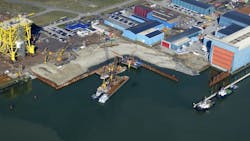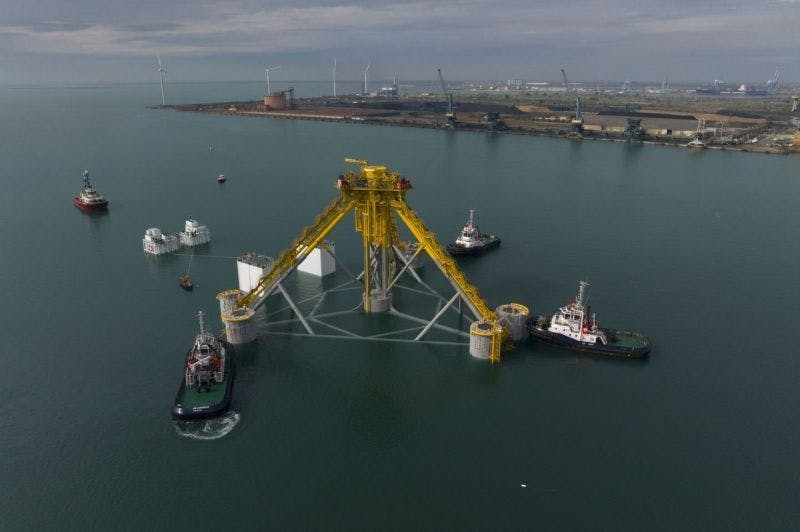Fabricator adds giant DC platforms to offshore wind portfolio
Editor's note: This feature first appeared in the March-April 2024 issue of Offshore magazine. Click here to view the full issue.
By Jeremy Beckman, Editor-Europe
Offshore wind farm developments are expanding in size and extending out to deeper waters, and suppliers of the platforms and support structures are having to adapt their facilities accordingly. One of the early movers is Eiffage Métal, which is investing heavily in new assembly areas for fixed and floating offshore wind.
Smulders, the group’s engineering and construction subsidiary based in Belgium, recently formed a partnership with the Meyer Group, which includes Neptun Werft, to fabricate offshore wind converter platforms at the latter’s site in Warnemünde on the German Baltic Sea coast. They are establishing two new companies, Neptun Smulders Offshore Renewables and Neptun Smulders Engineering, to manage the design and production process.
In addition, Smulders has acquired a large new yard in Vlissingen in the southern Netherlands from ôHillebrand ASK Romein. While the company’s existing sites in Hoboken, Belgium and Wallsend, northern England, will continue to focus on AC substation topsides and jacket foundations, transformer modules and mass production of transition pieces, the Vlissingen location will be dedicated to construction of DC platforms and their jackets. Under the arrangement with Neptun Verft, the topsides and jacket for any DC platform awarded to Neptun Smulders could be built either at Rostock, northern Germany or at Vlissingen, or shared, depending on the project location and the two yards’ workloads.
According to Arnaud De Villepin, Director Energy & Industry at Eiffage Métal, Smulders has built over 30 AC platforms for fixed offshore wind developments over the past 15 years, but the size of DC platforms is in a different league – 20,000 t or more for the topsides and around 10,000 t for the jackets. “While AC platforms suit single wind farm developments and will remain the same size in future, DC platforms provide the capability to connect additional developments to the same power network. That is why we acquired the Vlissingen yard, which also provides load-out capability.” The investments are running at full speed for the development of the site and its halls, and the construction of load in and out quays.
Assembly of the three floaters for the second pilot, Ocean Winds’ Les Eoliennes Flottante du Golfe du Lion (EFGL), began at Fos last December. The project will feature three 10-MW wind turbines on three semisubmersible Windfloat structures. Each of the floaters will have nine columns, fabrication of which was subcontracted in Turkey, with the final sections due to reach Fos last month. As EPCI contractor, Eiffage Métal expects to complete assembly of the floaters in the near future, for eventual installation 30 km offshore Leucate, north of France’s border with Spain in the Mediterranean.
“The concepts for these two projects are quite different,” De Villepin explained. “PGL is a TLP design and the floaters were shaped like pyramids, and this presented difficulties with mounting scaffolding on an incline and placement of the bracings for the assembly works of the substructure. EFGL has been a little easier in terms final erection, as the columns are assembled vertically with the bracings on top. The main logistical issue is the same as with PGL, the size of the completed structures for the floatover installation.
“We are now also performing engineering for the future industrialization of floater fabrication to serve the next phase of commercial-scale floating offshore wind developments. Floaters account for around 50% of the capex, so it will be very important to offer a competitive price via serial fabrication, which can deliver substantial efficiency gains. The difficulty, again, is the logistics, the yard space needed for mass production of these 4,000-t structures, each 25-30 m tall [82-128 ft], with a radius of 100 m [328 ft]. However, we have the possibility to extend the site at Fos, with no neighbors on one side. Today the yard can make six to seven floaters per year, but our target is to produce 30 per year in future.
“The capacity of France’s next planned floating offshore wind farms will be 250 MW each, even higher later on. With the coming 20-MW output turbines, that could create a need for 15 floaters per project. We are adopting a two-pronged strategy: one approach is to let the developers take care of the designs for the heavier floating support structures, with Eiffage Métal acting solely as the EPC contractor. But we are also developing our own proprietary design, and we are in talks with the Marseille Ports Authority on investing in a new terminal in front of Fos that could be ready by 2030.”
The first of two tenders for new French floating offshore wind farms was due to close last month, with the award of the AO5 area offshore Brittany to a utility. The second tender AO6 covers two areas. One, in front of the coastal town of Port-la-Nouvelle, will be an extension of the EFGL and Gruissan pilots; the second will be located near the Fos-sur-Mer coastline. All projects call for 250 MW of capacity with the tenders for construction set to be issued in the next two to three years. Eiffage Métal is also monitoring the opening up of the floating offshore wind sector around the shores of Italy, Norway and UK.
About the Author
Jeremy Beckman
Editor, Europe
Jeremy Beckman has been Editor Europe, Offshore since 1992. Prior to joining Offshore he was a freelance journalist for eight years, working for a variety of electronics, computing and scientific journals in the UK. He regularly writes news columns on trends and events both in the NW Europe offshore region and globally. He also writes features on developments and technology in exploration and production.


